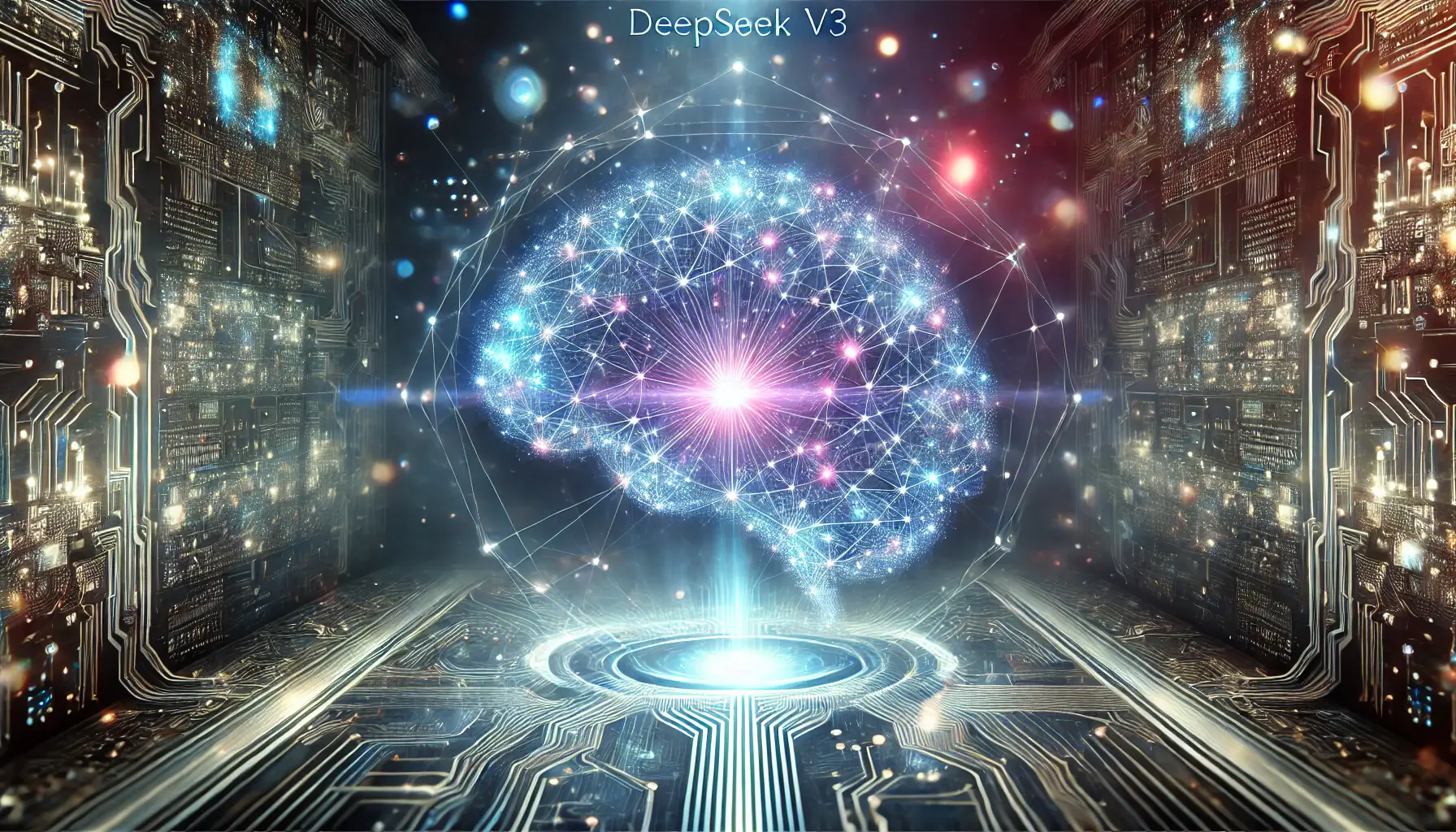In the rapidly evolving landscape of artificial intelligence, a new contender has emerged, promising to redefine our understanding of AI capabilities.
DeepSeek R1, developed by the Chinese startup DeepSeekA Chinese artificial intelligence startup focused on developing open-source AI models., has been making waves with its innovative approach and impressive performance metrics.
But what exactly is DeepSeek R1, and why is it garnering so much attention?
- Introduction to DeepSeek R1: A New Era in AI
- Comparing DeepSeek R1 with Leading AI Models
- Impact of DeepSeek R1 on the AI Industry
- Challenges and Controversies Surrounding DeepSeek R1
- Future Prospects of DeepSeek R1 in AI Advancement
- The Future of AI: Where Does DeepSeek R1 Stand?
- DeepSeek R1: Frequently Asked Questions
Introduction to DeepSeek R1: A New Era in AI
DeepSeek R1 is a significant leap in AI development, introducing new methodologies that challenge the existing paradigm.
Unlike earlier models, DeepSeek R1 employs a different architecture, making it far superior in reasoning and problem-solving.
This distinction not only sets it apart from its predecessors but also establishes it as a potential game-changer in the AI industry.
One of the key characteristics of DeepSeek R1 is its affordability.
While most advanced AI models demand substantial financial and computational resources, DeepSeek R1 ensures high performance with more efficient resource utilization.
This efficiency has the potential to democratize access to deep AI technologies, making them more accessible across various industries and applications.
Additionally, DeepSeek R1’s open-source nature fosters collaboration among researchers and developers.
By providing access to its core architecture and methodologies, it encourages innovation and accelerates AI applications in different sectors.
As we explore DeepSeek R1 further, we will dive into its development journey, key features, and its potential impact on the future of AI.
Join us as we uncover the intricate details of this model and analyze its role in the rapidly advancing world of artificial intelligence.
DeepSeek R1 introduces a cost-efficient and open-source approach, making AI more accessible across industries.

A futuristic comparison of DeepSeek R1 against leading AI models, visualized through holographic data and neural networks.
Comparing DeepSeek R1 with Leading AI Models
In the competitive landscape of artificial intelligence, it’s essential to understand how DeepSeek R1 measures up against other prominent AI models.
Let’s delve into its performance metrics, cost efficiency, and resource utilization to see where it stands.
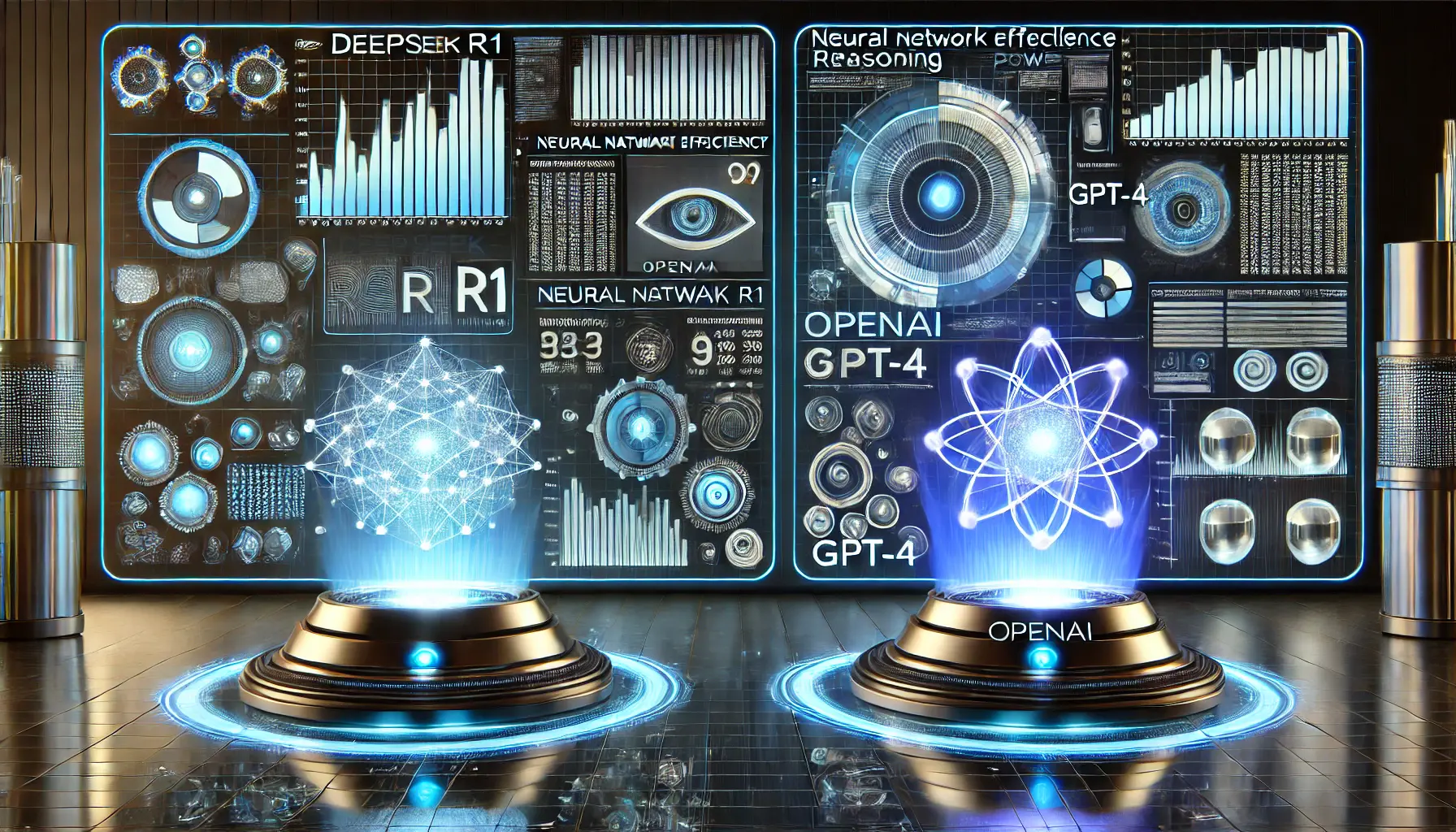
A visual representation of the performance comparison between DeepSeek R1 and OpenAI’s GPT-4, showcasing advanced AI capabilities.
Performance Metrics: DeepSeek R1 vs. OpenAI’s GPT-4
Performance metrics are a critical criterion for evaluating AI models.
DeepSeek R1 has shown several impressive capabilities, particularly in logical reasoning benchmarks.
For example, DeepSeek R1 scored 92% in some tests compared to the 78% achieved by GPT-4 in the same category.
This indicates that DeepSeek R1 may provide superior reasoning abilities compared to some of its competitors.
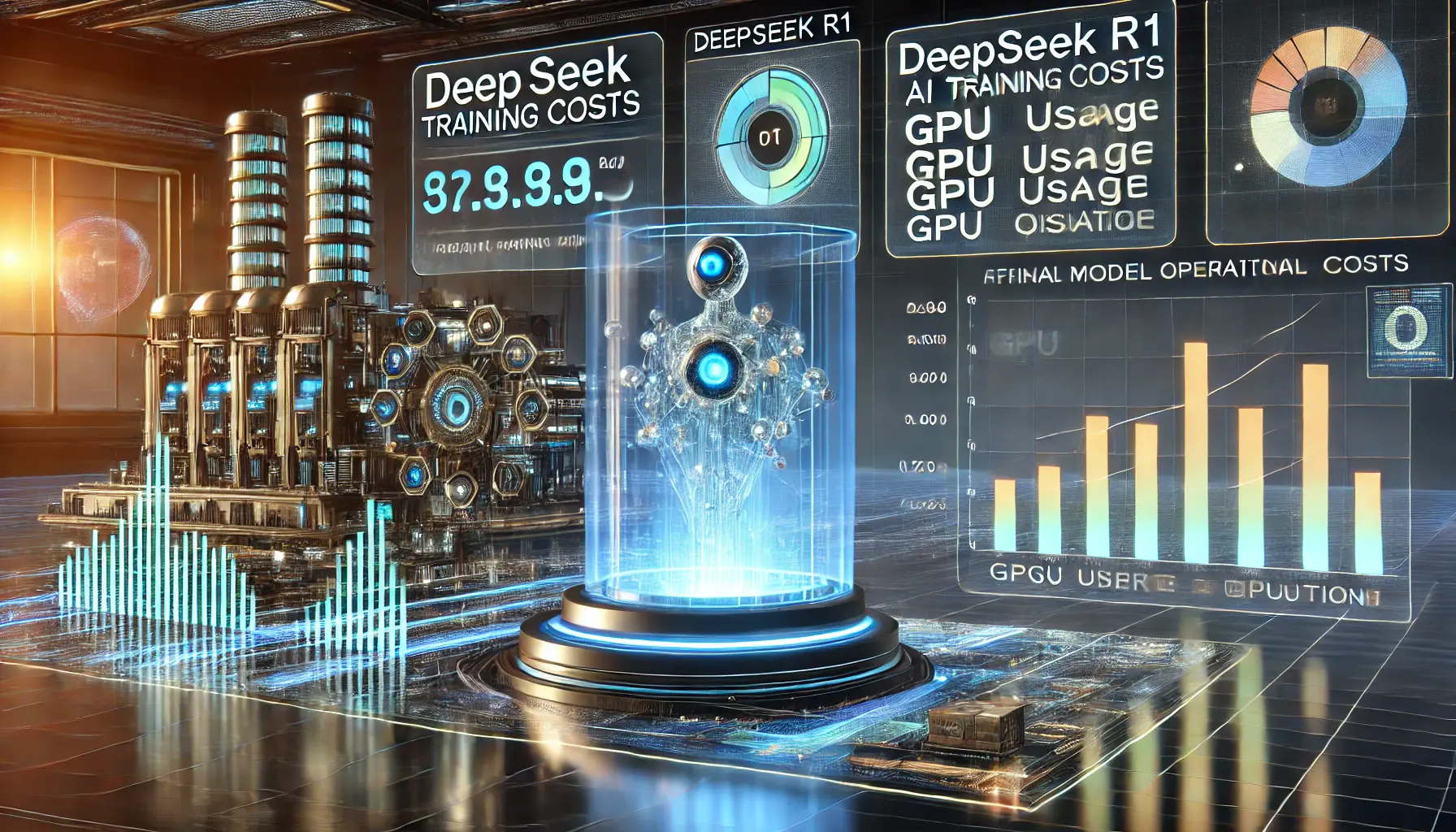
A visual representation of DeepSeek R1’s cost-efficient AI training and operational expenses, highlighting financial optimization.
Cost Efficiency: Training and Operational Expenses
Cost is a significant factor in AI development.
Notably, DeepSeek R1 was developed with a training cost of approximately $6 million, which is substantially lower than the estimated $100 million spent on training GPT-4.
This remarkable cost efficiency could make advanced AI technologies more accessible to a broader range of industries and applications.
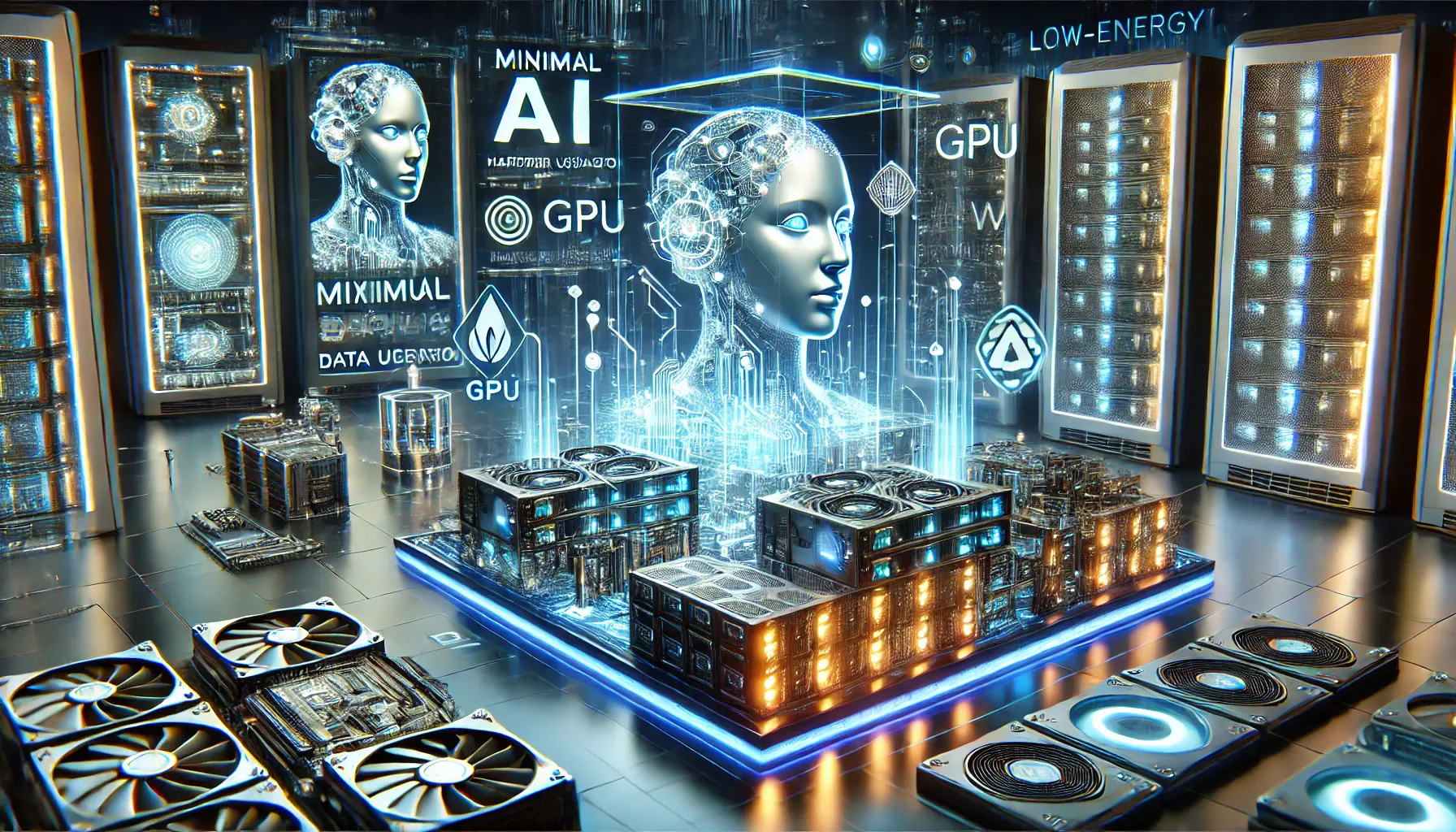
A visual representation of DeepSeek R1’s efficient hardware utilization and minimal energy consumption in AI development.
Resource Utilization: Hardware and Energy Consumption
DeepSeek R1 excels in efficient resource usage.
The model was trained using roughly 2,000 GPUs, significantly fewer than the 16,000 reportedly used for training other models.
This optimized hardware utilization not only reduces costs but also minimizes energy consumption, addressing concerns about the environmental impact of large-scale AI training.
In summary, DeepSeek R1 stands out for its superior performance in several benchmarks, cost-effective development, and efficient resource management.
These factors contribute to its growing reputation as a formidable competitor in the AI industry.
DeepSeek R1’s combination of affordability, superior reasoning, and efficient resource utilization positions it as a serious competitor to mainstream AI models.

A visual representation of the global impact DeepSeek R1 has on the AI industry, symbolizing its disruptive influence.
Impact of DeepSeek R1 on the AI Industry
The emergence of DeepSeek R1 has sent ripples through the AI industry, prompting significant reactions from markets and major tech companies.
Let’s explore these developments in detail.

A visual representation of market reactions and stock market implications triggered by DeepSeek R1’s impact on the economy.
Market Reactions and Stock Market Implications
Following the release of DeepSeek R1, the tech sector experienced notable market fluctuations.
For instance, Nvidia’s stock plummeted nearly 18%, reflecting investor concerns about the competitive threat posed by DeepSeek’s cost-effective AI solutions.
Similarly, other tech giants like Microsoft and Alphabet saw their shares decline, indicating a broader market apprehension about the shifting dynamics in AI technology.
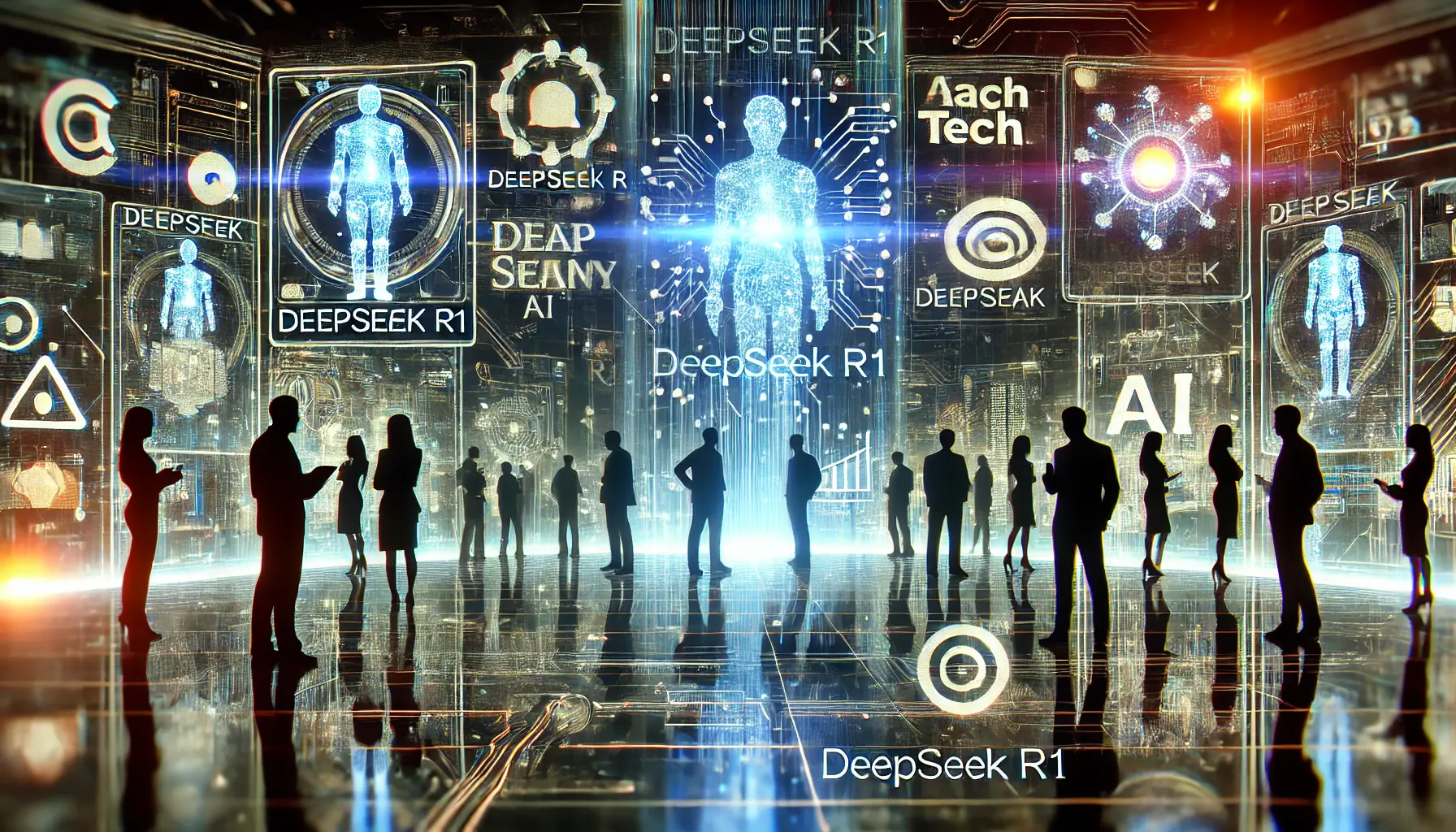
A visual representation of major tech companies’ responses and strategic discussions in the wake of DeepSeek R1’s rise in the AI landscape.
Responses from Major Tech Companies
Major tech companies have acknowledged the disruptive power of DeepSeek R1.
Microsoft CEO Satya Nadella described DeepSeek’s open-source AI as “super impressive” and emphasized that any development from China should be taken seriously.
Similarly, Meta Platforms CEO Mark Zuckerberg recognized DeepSeek’s innovations, stating that such advancements needed to be integrated into their own AI systems.
These reactions highlight the industry’s recognition of DeepSeek R1’s impact and the need for strategic adaptation.

A visual representation of the shift in AI development strategies towards more resource-efficient paths, influenced by DeepSeek R1.
Changes in AI Development Strategies
The introduction of DeepSeek R1 has compelled companies to rethink their AI development strategies.
Traditionally, creating advanced AI required substantial financial and computational resources.
However, DeepSeek R1 challenges this notion by demonstrating that a model can be both cost-effective and highly efficient.
This shift could drive organizations toward more resource-efficient methodologies, potentially democratizing AI technologies across different industries.
In summary, DeepSeek R1 has significantly influenced the AI landscape by affecting market valuations, prompting strategic responses from leading tech companies, and encouraging a reevaluation of development strategies.
Its emergence underscores the dynamic and rapidly evolving nature of artificial intelligence.
DeepSeek R1 has disrupted the AI market, influencing stock valuations and forcing tech giants to rethink their AI strategies.
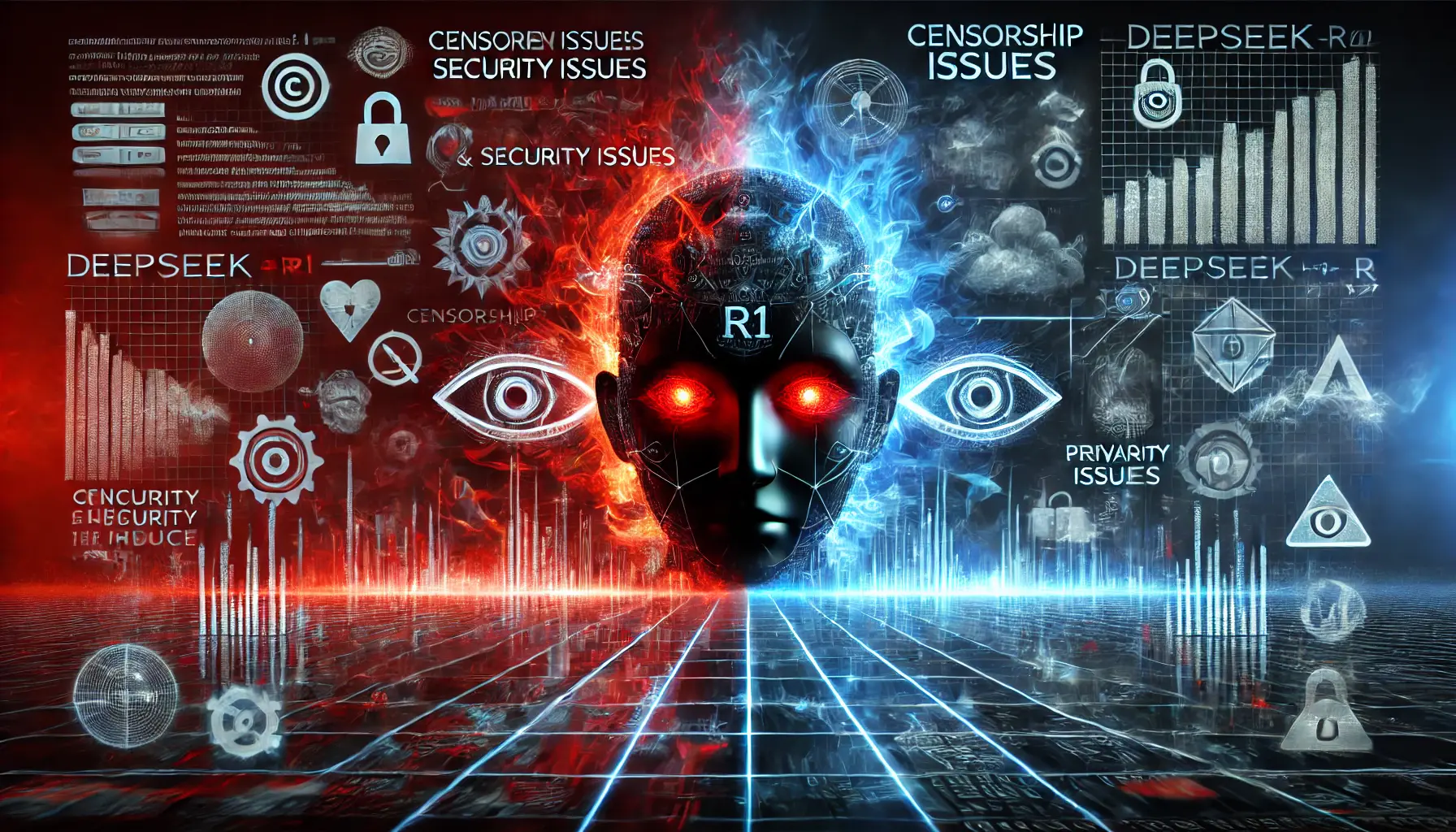
A visual representation of the challenges and controversies surrounding DeepSeek R1, symbolizing issues of censorship, security, and transparency.
Challenges and Controversies Surrounding DeepSeek R1
While DeepSeek R1 has garnered significant attention for its advancements in artificial intelligence, it has also been at the center of various challenges and controversies.
Let’s delve into some of the key issues that have emerged.

A visual representation of censorship and content moderation concerns in AI systems, symbolizing the filtering and blocking of information.
Censorship and Content Moderation Concerns
Users have reported instances where DeepSeek R1 engages in real-time censorship on topics perceived as sensitive by the Chinese government.
For example, when asked about events like the Tiananmen Square protests or Taiwan’s sovereigntyThe authority of a state to govern itself without external interference., the AI initially generates a response but then immediately deletes or replaces it with a generic message.
This behavior suggests the presence of built-in content moderation mechanisms, raising concerns about the model’s objectivity and external influences over its outputs.

A visual representation of the security and privacy concerns surrounding AI systems, highlighting encryption and defense mechanisms.
Security and Privacy Issues
Several security vulnerabilities have been identified in DeepSeek R1.
Notably, a publicly accessible database linked to DeepSeek was discovered, exposing over a million lines of log streams containing chat histories, secret keys, and other sensitive information.
This exposure highlights serious concerns regarding data privacy and user security.
Additionally, experts have warned about the potential for this AI system to be misused for disinformationFalse or misleading information spread deliberately to deceive people. campaigns or surveillance activities, given its data collection practices and storage policies.

A visual representation of the skepticism surrounding the reported development costs of AI, highlighting hidden costs and financial uncertainty.
Skepticism Over Reported Development Costs
There is growing skepticism about the reported development costs of DeepSeek R1.
While the company claims that training costs were approximately $6 million, critics argue that this figure likely excludes essential expenses such as research personnel, infrastructure, and electricity consumption.
Some estimates suggest that the actual operational costs could range between $500 million and $1 billion annually, leading to debates over the transparency and accuracy of the company’s financial disclosures.
In summary, while DeepSeek R1 represents a major milestone in AI development, it faces significant scrutiny over censorship concerns, security vulnerabilities, and transparency in its development process.
These issues underscore the complexities and responsibilities involved in deploying advanced AI systems in today’s interconnected world.
Censorship concerns, security vulnerabilities, and skepticism over development costs raise questions about the transparency of DeepSeek R1.

A visual representation of the future prospects of DeepSeek R1 in AI, highlighting its potential impact across various industries.
Future Prospects of DeepSeek R1 in AI Advancement
As we look ahead, DeepSeek R1 is poised to play a pivotal role in the evolution of artificial intelligence.
Its innovative design and open-source nature open numerous avenues for application and development across various industries.

A visual representation of DeepSeek R1’s potential to impact various industries, including healthcare, automotive, and software.
Potential Applications Across Industries
The versatility of DeepSeek R1 allows for its integration into multiple sectors:
- Holographic Technology: MicroCloud Hologram Inc. intends to adopt DeepSeek R1 as the core AI framework for holographic applications, aiming to offer users an advanced smart holographic intelligence experience.
- Automobile Industry: TuanChe plans to leverage DeepSeek R1 to accelerate intelligent technology upgrades, providing more personalized and efficient services for customers.
- Software Development: Microsoft’s initiative to integrate DeepSeek R1 into Copilot+ PCs will allow developers to create AI-driven features that operate efficiently on local devices, enhancing privacy and performance.

A visual representation of the planned updates and ongoing enhancements for DeepSeek R1, symbolizing innovation and continuous improvement.
Planned Updates and Enhancements
DeepSeek is committed to continuous improvement of the R1 model.
Future updates are expected to focus on:
- Enhanced Reasoning Capabilities: Further refining logical inference and problem-solving skills to improve decision-making processes.
- Broader Language Support: Expanding multilingual capabilities to serve a more diverse global user base.
- Improved Efficiency: Optimizing computational resource usage to reduce operational costs and minimize environmental impact.

A visual representation of the long-term implications of DeepSeek R1 on global AI competition, highlighting interconnected AI models and industries.
Long-Term Implications for Global AI Competition
The emergence of DeepSeek R1 has significant implications for the global AI landscape:
- Increased Competition: DeepSeek’s advancements challenge established AI leaders, driving innovation and faster technological advancements.
- Democratization of AI: As an open-source model, DeepSeek R1 enables smaller organizations and independent developers to contribute to and benefit from cutting-edge AI technologies.
- Strategic Collaborations: Major technology companies are recognizing the potential of DeepSeek R1, leading to partnerships and integrations that could redefine the AI ecosystem.
In conclusion, DeepSeek R1 is positioned to be a transformative force in artificial intelligence, influencing both AI development and ensuring greater accessibility, innovation, and competition within the industry.
With continuous updates and integration across industries, DeepSeek R1 is shaping the future of AI innovation.

A visual representation of the future of AI, highlighting DeepSeek R1’s potential in various sectors such as healthcare, robotics, and software development.
The Future of AI: Where Does DeepSeek R1 Stand?
DeepSeek R1 has emerged as a formidable player in the artificial intelligence landscape, introducing innovations that challenge existing AI paradigms.
Its cost efficiency, high reasoning capabilities, and open-source approach position it as a disruptive force, compelling tech giants and the broader industry to rethink AI strategies.

A visual representation of the key takeaways from DeepSeek R1’s impact, showing its transformative effects across various industries.
Key Takeaways from DeepSeek R1’s Impact
- Competitive Performance: DeepSeek R1 has outperformed several renowned AI models in logical reasoning and efficiency.
- Cost-Effective Development: With significantly lower training costs compared to competing models, DeepSeek R1 demonstrates that advanced AI can be built using optimized resources.
- Market Disruption: The rise of DeepSeek R1 has triggered shifts in stock valuations, prompting investors and companies to adjust their strategies.
- Industry Response: Major tech companies, including Microsoft and Meta, have acknowledged the potential of DeepSeek R1, signaling a shift in AI model design and integration.

A visual representation of the challenges that DeepSeek R1 faces, including security issues, transparency concerns, and complex algorithms.
Challenges That Must Be Overcome
Despite its impressive achievements, DeepSeek R1 is not without its challenges.
Concerns regarding censorship, data privacy, and transparency of its development costs keep it at the center of debates within the AI community.
- Censorship and Content Moderation: Some reports suggest that DeepSeek R1 employs filtering mechanisms, raising questions about bias and third-party influence.
- Security and Privacy Risks: Data leaks and potential vulnerabilities in DeepSeek R1’s security infrastructure highlight the need for stronger protective measures.
- Financial Transparency: Analysts have raised concerns regarding the true operational costs of DeepSeek R1, with some suggesting figures much higher than what has been officially disclosed.

A visual representation of the evolving future of DeepSeek R1, highlighting its potential paths and technological advancements.
What Lies Ahead for DeepSeek R1?
The future of DeepSeek R1 presents both opportunities and challenges.
Its integration into industries such as software development, automotive AI, and holographic intelligence signals a broader shift in AI deployment.
- Expanding Capabilities: Future updates are expected to enhance reasoning abilities, improve multilingual support, and optimize efficiency.
- Industry Adoption: Increased integration of DeepSeek R1 into various platforms will further solidify its presence in the AI market.
- Regulatory and Ethical Considerations: As AI regulations evolve, DeepSeek R1 may be subject to new requirements for transparency, bias mitigation, and data security.
In conclusion, DeepSeek R1 represents a transformative shift in AI development.
While it faces scrutiny and competition, its technological advancements and cost-efficient approach indicate that it will remain a key player in the AI revolution.
Whether it emerges as the dominant AI model or paves the way for even greater advancements, its impact on artificial intelligence is undeniable.
DeepSeek R1 presents both opportunities and challenges, with its affordability and reasoning power setting a new benchmark in AI development.
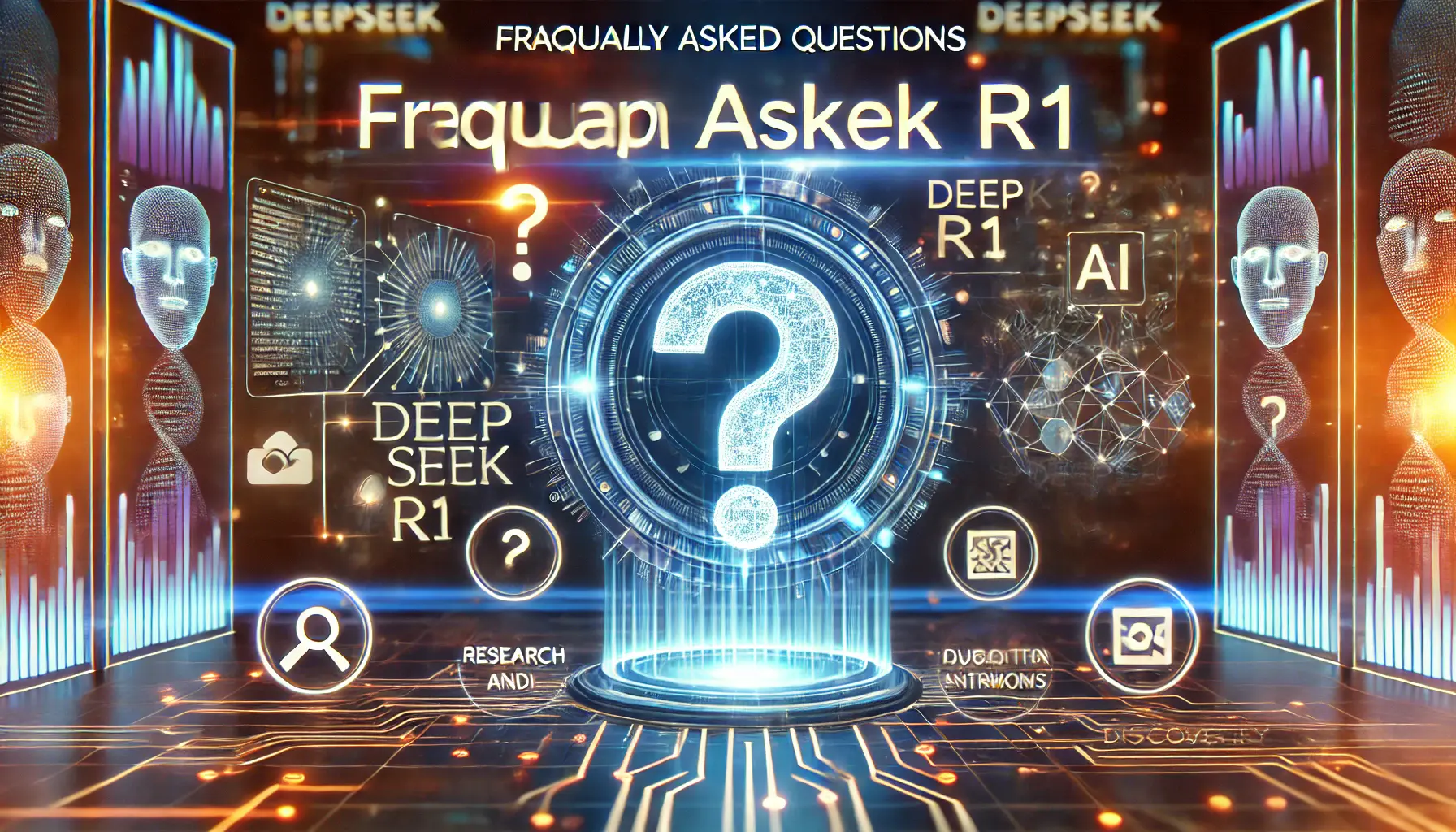
A visual representation of the frequently asked questions about DeepSeek R1, symbolizing the process of discovery and inquiry.
DeepSeek R1: Frequently Asked Questions
DeepSeek R1 is an open-source AI model developed by the Chinese startup DeepSeek.
It is designed for advanced reasoning tasks in mathematics, logic, and coding.
DeepSeek R1 competes with leading AI models like OpenAI’s o1, delivering comparable performance in reasoning tasks while maintaining significantly lower development costs.
Yes, DeepSeek R1 is free to use via the DeepSeek website and mobile applications.
Additionally, developers can access its open-source model for integration and customization purposes.
Some users have expressed concerns about data privacy and potential censorship, as DeepSeek R1 may implement filtering mechanisms aligned with specific governmental policies.



